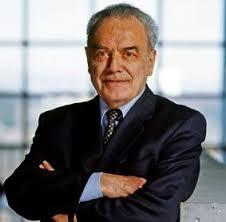
WERNER ARBER
Werner ARBER est un microbiologiste et un généticien Suisse.
Institutions : Université de Genève, Université de Californie du Sud, Université de Berkely, Université Stanford, Univesité de Bâle. Il a exploré les mécanismes moléculaires de la variation génétique spontanée à la base de l’évolution biologique.Il a obtenu en 1978 le Prix Nobel de physiologie ou médecine avec Hamilton Smith et Daniel Nathans pour la découverte de l'enzyme de restriction. Leur travail a contribué au développement des technologies liées à l'ADN recombinant.
CURRICULUM VITAE
Werner Arber, born 1929, obtained his academic education in natural sciences at the ETH in Zürich and at the University of Geneva. After postdoctoral work in the USA he returned in 1960 as research associate to the University of Geneva where he later became promoted to associate professor. In 1970-1971 he spent one year as a research professor at the University of California in Berkeley before taking a full professorship for molecular microbiology at the Biozentrum of the University of Basel. From 1986-1988 he was rector of the University of Basel. He retired in 1996. His scientific activities concern microbial genetics, molecular genetics and biotechnology and more specifically, bacteriophage genetics and lysogeny, phage-mediated transduction, bacterial restriction and modification systems, site-specific recombination, transposition of mobile genetic elements, molecular mechanisms of genetic variation and molecular evolution.In 1978 Werner Arber was honored with the "Nobel Prize" in Medicine for the discovery of restriction enzymes and their application to problems of molecular genetics. He also received several honorary doctoral degrees and he is either member or honorary member of a number of scientific academies and societies, such as EMBO, the Pontifical Academy of Sciences, the Academia Europea, the National Academy of Sciences of the USA, the American Academy of Arts and Sciences, the American Academy of Microbiology, the Korean Academy of Sciences and Technology, the Third World Academy of Sciences (TWAS), the Spanish Academy of Engineering, the Swiss Academy of Natural Sciences, the Swiss Academy of Engineering Sciences and the Swiss Academy of Medical Sciences.Werner Arber also devoted part of his activities to national and international science politics. Among others, he was for 11 years member and vice-president of the Swiss Science Council. From 1996 to 1999 he was president of the International Council for Science (ICSU). In all of his activities he promoted broad interdisciplinary collaboration on the basis of scientific excellence of the involved partners. Since December 2010 he is the President of the Pontifical Academy of Sciences.
Selected Major Publications of Werner Arber
Biozentrum, University of Basel (Switzerland)
1) Arber, W., Kellenberger, G. &Weigle, J. (1957) La défectuosité du phage Lambda transducteur. Schweiz. Z. Path. Bakt. 20, 659-665Arber, W., Kellenberger, G. &Weigle, J. (1960).The defectiveness of Lambda transducing phage.In: E.A. Adelberg (ed.) Papers on bacterial genetics. Little, Brown & Co., Boston-Toronto, pp. 224-229.
2) Arber, W. (1960) Transduction of chromosomal genes and episomes in Escherichia coli. Virology 11, 273-288
3a) Arber, W. &Dussoix, D. (1962) Host specificity of DNA produced by Escherichia coli. I. Host controlled modification of bacteriophage . J. Mol. Biol. 5, 18-36
3b) Dussoix, D. & Arber, W. (1962) Host specificity of DNA produced by Escherichia coli. II. Control over acceptance of DNA from infecting phage . J. Mol. Biol. 5, 37-49
4) Arber, W. (1965) Host-controlled modification of bacteriophage. Annu. Rev. Microbiol. 19, 365-378
5) Arber, W. &Linn , S. (1969) DNA modification and restriction. Annu. Rev. Biochem. 38, 467-500
6) Arber, W., Iida, S., Jütte, H., Caspers, P., Meyer, J. &Hänni, C. (1979) Rearrangements of genetic material in Escherichia coli as observed on the bacteriophage P1 plasmid. Cold Spring Harbor Symp. Quant. Biol. 43, 1197-1208
7) Sengstag, C. & Arber, W. (1983) IS2 insertion is a major cause of spontaneous mutagenesis of the bacteriophage P1: non-random distribution of target sites. EMBO J. 2, 67-71
8) Iida, S., Meyer, J. & Arber, W. (1983) Prokaryotic IS elements.In: J. Shapiro (ed.) Mobile Genetic Elements. Academic Press, N.Y., pp. 159-221
9) Olasz, F., Stalder, R. & Arber, W. (1993) Formation of the tandem repeat (IS30)2 and its role in IS30-mediated transpositional DNA rearrangements. Mol. Gen. Genet. 239, 177-187
10) Naas, T., Blot, M., Fitch, W.M. & Arber, W. (1994) Insertion sequence-related genetic variation in resting Escherichia coli K-12. Genetics 136, 721-730
11) Arber, W. (1995) The generation of variation in bacterial genomes. J. Mol. Evol. 40, 7-12
12a) Arber, W. (2000) Genetic variation: molecular mechanisms and impact on microbial evolution. FEMS Microbiol. Rev. 24, 1-7
12b) Arber, W. (2002) Evolution of prokaryotic genomes.In: Current Topics in Microbiology and Immunology, Vol. 264/I, Pathogenicity Islands and the Evolution of Pathogenic Microbes. (J. Hacker & J.B. Kaper, eds.) pp. 1-14